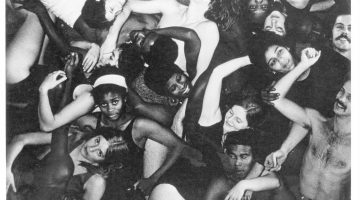“Life Isn’t Always Pretty or in Focus”
By John Held, Jr.

Patricia Jordan
“Jess at Stinson Beach”
1952
(Collection of Lorna Anthea Star Jordan).
Courtesy of the Crocker Art Museum
The Sixties were a time of communes and community, but they were foregrounded in the Fifties, when artists were banding together for mutual support to escape the banalities of the era. As such, we have books and exhibitions like Semina Culture (Distributed Art Publishers, 2005) which celebrates the group of artists and poets orbiting around Wallace Berman, and more recently the Crocker Museum, Sacramento, exhibition, “An Opening of the Field: Jess, Robert Duncan and Their Circle,” which examines the wide swath of artists associated with the collagist and painter Jess and his poet partner, Robert Duncan. That these figures are associated with the Bay Area in advance of the Summer of Love is more than coincidence, for many of these artists played significant roles in ushering in a new era of thought and lifestyle.

Patricia Jordan
“Robert Duncan”
Circa 1960
(Collection of Kenneth Irby, Lawrence, Kansas)
Courtesy of the Crocker Art Museum
There was a special camaraderie in those days, fueled by the fore mentioned bleakness of the bourgeoisie, and in some cases, the collegial intake of stimulants. Not to mention the new direction in art, prose and verse that was transpiring in reaction to the prevailing domination of Abstract Expressionism. We look back at that time and certain individuals leap out at us, forgetting all too often that many others of perhaps lesser talent, certainly lesser renown, accompanied them through the pathways of the era.

Wallace Berman
Mail Art to Robert Duncan and Jess
Circa 1962
(Collection Philip Aarons and Shelly Fox Aarons)
Courtesy of the Crocker Art Museum
Such is the case with, “An Opening of the Field.” Included are well documented figures of the time, including the legendary Wallace Berman, painters Llyn Foulkes and R. B. Kitaj, filmmakers Lawrence Jordan and James Broughton, assemblagist George Herms, actor Dean Stockwell, and the poet Michael McClure. But we are also introduced to a cast of, if not forgotten, slighted characters of the period, including Norris Embry, Tom Field, Virginia Admiral, Philip Roeber, Paul Alexander, Ronald Bladen, Lyn Brown Brockway, Jack Boyce, Tom Field, Nemi Frost, Eloise Mixon, Madeline Gleason, and Miriam Hoffman.

Virginia Admiral
“The Red Table” (detail)
1944
(Collection of Anne and Robert Bertholf)
Courtesy of the Crocker Art Museum
Many of these marginal players have extraordinary stories to tell. None more so than the mother of film actor Robert De Niro, whose mother Virginia Admiral, was a fiery leftist at UC Berkeley, later going on to study painting with Hans Hofmann in New York. After her marriage to Robert DeNiro, Sr., the more recognized painter of the pair, she often hosted Robert Duncan on his visits to New York. Her painting, “The Red Table,” hung in Duncan’s home office, after first being shown at Peggy Guggenheim’s path breaking gallery, Art of This Century.

Miriam Hoffman
“Goddess” (detail)
1953
Crocker Art Museum
(Gift of Curlen Phipps and Michele Greenhouse-Phipps)
Courtesy of the Crocker Art Museum
One of the more fascinating artists in the exhibition is Miriam Hoffman, who was born in New York and bounced between there and San Francisco in the late Forties and early Fifties. She enrolled in the California School of Fine Arts (now the Art Institute) in 1949 and began showing sculpture and assemblage at Jess’s King Ubu gallery in 1951. In the late Fifties, she disappeared, thought to be dead. It was only in 1995, when John Natsoulas was preparing an exhibition on Jess’s King Ubu gallery, that the truth was revealed. She had run away to San Diego and became a recluse.
As she related to Natsoulas, “I don’t really recall everything, but I was mostly fed up with the art world and I found that I was not really appreciated for who I was, but for my artwork. I signed a contract with Gumps that scared me, because I knew I couldn’t survive without the other galleries and that contract excluded me from dealing with them. Together, with the help of my friends, we took all of the work out of Gumps and had a big sale. The rest of the work that was large was dropped off at the beach in the Avenues. I had no remorse – I was ready to move on. I collected so many things from the ocean that I was now giving it all back. I wasn’t aware that people thought I had died. Then again, I stayed in touch with nobody.” (John Natsoulas, et al., The Beat Generation Galleries and Beyond, John Natsoulas Press, Davis, California, 1996)

Jess
“Sent on the VII Wave”
Collage and Mixed Media
1979
(The Buck Collection, Laguna Beach, CA)
Courtesy of the Crocker Art Museum
I have some qualms about this exhibition. Reaching far and wide to be as inclusive as possible, the curators (Michael Duncan and Christopher Wagstaff) incorporated a lot of flotsam and jetsam of the era, which unevenly floats around the vast exhibition hall of the Crocker. But, so what. Isn’t that the way of the world that is usually eliminated from the history books? Life isn’t always pretty or in focus and neither is this show. But it reveals a truth that most exhibitions pass on for the sake of “quality,” “historical importance,” and “critical integrity.” There’s a sloppy comprehensiveness to the exhibition that appeals to me. A discerning eye can separate the wheat from the chaff and follow up on extracurricular quests for additional information on the many interesting and sometimes eccentric characters that composed the dramatic domesticity of Jess Collins and Robert Duncan.
“An Opening of the Field: Jess, Robert Duncan and Their Circle.”
Crocker Art Museum
216 O Street, Sacramento, California.
June 9 through September 1, 2013
For more information visit here.



